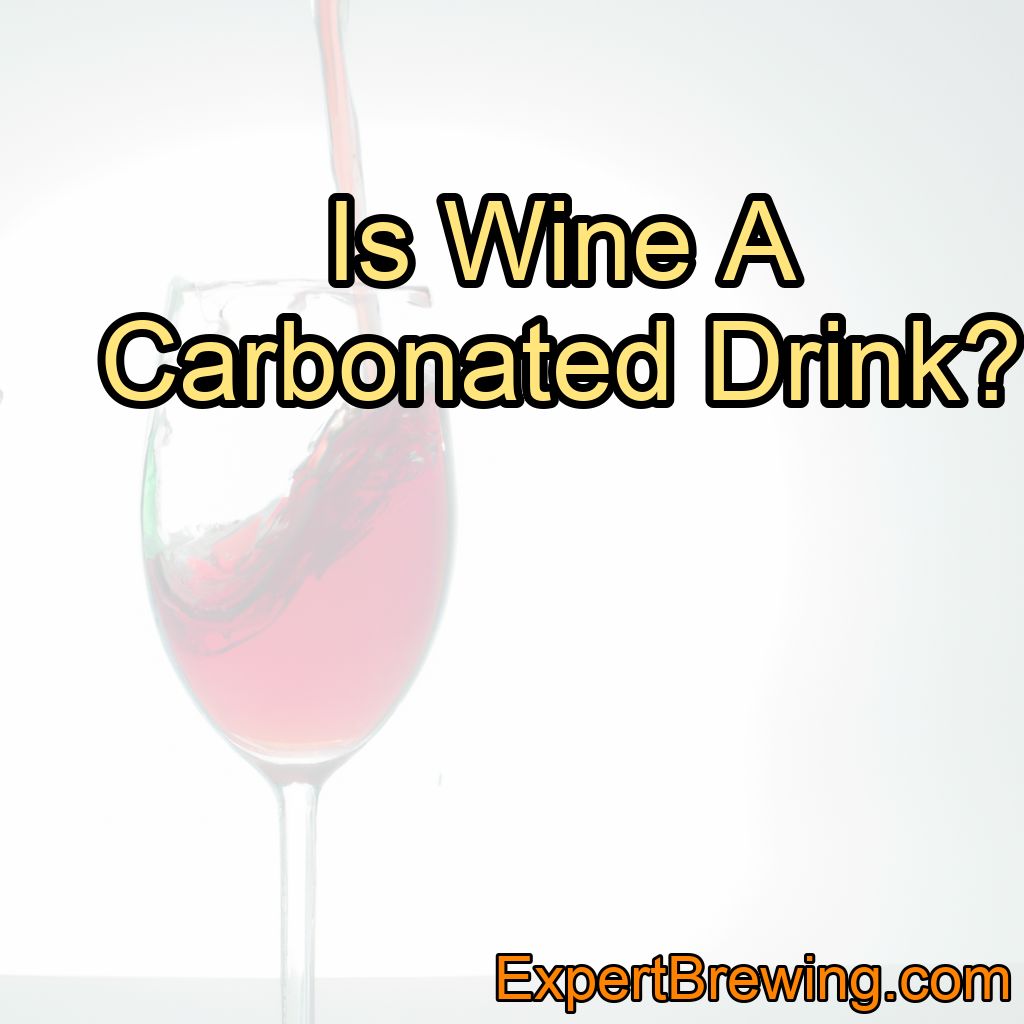Is wine a carbonated drink? The short answer is no, not all wine is carbonated.
However, some types of wine do contain some level of carbonation. In this blog post, we’ll dive deeper into the world of wine and explore different types of wine, the process of winemaking, and the specific types of wine that may contain carbonation.
As an experienced brewer and wine enthusiast, I have had the pleasure of tasting and learning about many different types of wine, and understanding the nuances that make each type unique.
What is considered a carbonated drink?
A carbonated drink is a beverage that contains dissolved carbon dioxide gas, which creates bubbles and gives it a fizzy texture. Examples include soda, sparkling water, champagne, and carbonated fruit juices.

Types of Wine
When discussing wine, it is important to understand the different types available. Broadly, wine can be classified into the following categories:
1. Red Wine: Made from red or black grapes, red wine gets its color from the grape skins. Examples include Cabernet Sauvignon, Merlot, and Pinot Noir.
2. White Wine: Produced from white grapes, or even red grapes with the skin removed, white wine includes varieties like Chardonnay, Sauvignon Blanc, and Riesling.
3. Rosé Wine: This type of wine is made from red grapes, but the grape skins are only in contact with the juice for a short period of time, giving it a pink color. Examples include Grenache Rosé and Pinot Noir Rosé.
4. Sparkling Wine: This category of wine has carbonation, either from natural fermentation or by adding carbon dioxide. The most famous example is Champagne, but other types include Prosecco and Cava.
5. Dessert Wine: Sweeter than other types of wine, dessert wines are typically enjoyed after a meal. Examples include Port, Sherry, and Sauternes.
The Winemaking Process
The process of making wine is complex and varies depending on the type of wine being produced. However, there are some basic steps shared across most types of wine:
1. Harvesting: Grapes are harvested when they reach the desired level of ripeness.
2. Crushing: The grapes are crushed to release their juice, which is then called “must.”
3. Fermentation: Yeast is added to the must, converting the sugars into alcohol and carbon dioxide.
4. Aging: The wine is aged in barrels, tanks, or bottles to develop flavors and complexity.
5. Bottling: The wine is bottled and sealed, ready for consumption.
Carbonation in Wine
Carbonation is the presence of carbon dioxide in a liquid, which creates bubbles and fizziness. Carbonation can occur naturally during the fermentation process, as yeast consumes sugar and produces both alcohol and carbon dioxide.

However, not all wines are carbonated.
Naturally Carbonated Wines
Some wines are naturally carbonated due to the fermentation process. In these cases, the wine undergoes a second fermentation in the bottle, which traps the carbon dioxide and creates the bubbles. Examples of naturally carbonated wines include Champagne and some types of Cava.
Artificially Carbonated Wines
Other wines are carbonated by adding carbon dioxide after the fermentation process is complete. This method is used to create wines like Prosecco and some types of sparkling wine. Artificially carbonated wines typically have larger, more forceful bubbles than their naturally carbonated counterparts.
Decanting Wine
Decanting is the process of pouring wine from its bottle into another container, typically a decanter or carafe. This process is often used for red wines to separate the sediment that can accumulate at the bottom of the bottle, as well as to aerate the wine and allow it to “breathe.” Decanting can also help to reduce the carbonation in a wine, as the agitation from pouring can help release some of the trapped carbon dioxide.
How to Serve Carbonated Wine
When serving carbonated wine, it is important to take care not to disturb the sediment that may be present at the bottom of the bottle.
To do this, store the bottle upright for at least 24 hours before serving, allowing any sediment to settle. When pouring the wine, do so slowly and steadily, without tilting the bottle too far.
Health Benefits of Wine
Moderate wine consumption has been linked to several health benefits, including:
1. Heart health: Drinking wine in moderation may help to reduce the risk of heart disease by increasing levels of “good” HDL cholesterol and reducing inflammation.
2. Antioxidants: Wine, particularly red wine, is high in antioxidants, which can help protect the body from free radicals and oxidative stress.
3. Cognitive function: Some studies have suggested that moderate wine consumption may help to maintain cognitive function as we age.
Conclusion
In conclusion, not all wine is carbonated, but some types of wine, such as sparkling wine, do contain carbonation. The carbonation in wine can be a result of either natural fermentation or artificial addition of carbon dioxide. As a wine enthusiast, it is important to understand the different types of wine, the winemaking process, and the specific types of wine that may contain carbonation. Here are some key facts about wine and carbonation:
1. Not all wine is carbonated, but some types, such as sparkling wine, do contain carbonation.
2. Carbonation can occur naturally during fermentation or be artificially added after fermentation.
3. Examples of naturally carbonated wines include Champagne and some types of Cava.
4. Examples of artificially carbonated wines include Prosecco and some types of sparkling wine.
5. Decanting can help to reduce carbonation in wine by allowing trapped carbon dioxide to escape.
6. When serving carbonated wine, store the bottle upright and pour slowly to avoid disturbing sediment.
7. Moderate wine consumption has been linked to heart health, antioxidants, and cognitive function.
8. Understanding the different types of wine and the winemaking process can enhance your wine appreciation and enjoyment.
FAQs
What kind of wine is carbonated?
Sparkling wine is the type of wine that is carbonated.
Do all wines have carbonation?
No, not all wines have carbonation. Carbonation refers to the presence of dissolved carbon dioxide gas in a beverage, which creates bubbles. While some wines, such as sparkling wines or Champagne, are intentionally carbonated, most wines are still, meaning they do not have carbonation.
Is Pinot Grigio supposed to be fizzy?
No, Pinot Grigio is not supposed to be fizzy. It is typically a still white wine, although there are some variations that may have a slight effervescence. However, the majority of Pinot Grigio wines are still and not intended to be fizzy.
Are white wines carbonated?
No, white wines are typically not carbonated. Carbonation in wine is usually associated with sparkling wines, such as Champagne or Prosecco, which undergo a secondary fermentation process to produce bubbles. Most white wines are still, meaning they do not have carbonation.
How can you tell if wine is carbonated?
To determine if a wine is carbonated, you can look for certain visual cues and characteristics. Carbonated wines typically have bubbles present in the glass, similar to sparkling water or soda. These bubbles can be seen rising to the surface of the wine. Additionally, carbonated wines may have a slight effervescence or fizziness when tasted, which can be detected on the tongue. It’s important to note that not all wines are carbonated, so these indicators are specific to sparkling or fizzy wines.




